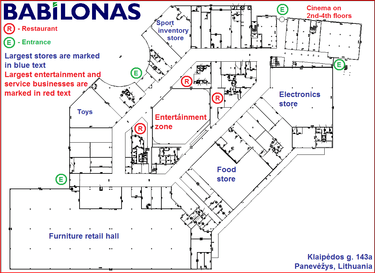Shopping mall
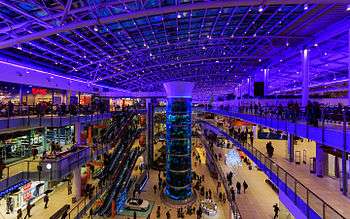
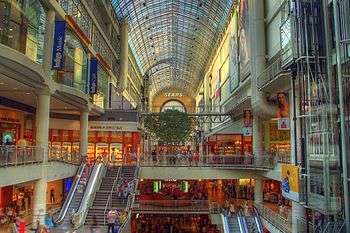
A shopping mall is a modern, chiefly North American, term for a form of shopping precinct or shopping center, in which one or more buildings form a complex of shops representing merchandisers with interconnecting walkways that enable customers to walk from unit to unit. A shopping arcade is a specific form serving the same purpose.
Many early shopping arcades such as the Burlington Arcade in London, the Galleria Vittorio Emanuele II in Milan, and numerous arcades in Paris are famous and still trading. However, many smaller arcades have been demolished, replaced with large centers or "malls", often accessible by vehicle. Technical innovations such as electric lighting and escalators were introduced from the late 19th century.
From the late 20th century, entertainment venues such as movie theaters and restaurants began to be added.[1][2] As a single built structure, early shopping centers were often architecturally significant constructions, enabling wealthier patrons to buy goods in spaces protected from the weather.
Regional differences
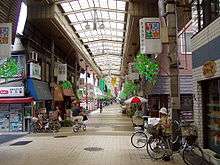

In places around the world, the term shopping centre is used, especially in Europe, Australia, and South America. Mall is a term used predominantly in North America.[3] Outside of North America, "shopping precinct" and "shopping arcade" are also used. In North America, Gulf countries, and India, the term shopping mall is usually applied to enclosed retail structures (and is generally abbreviated to simply mall), while shopping centre usually refers to open-air retail complexes; both types of facilities usually have large parking lots, face major traffic arterials, and have few pedestrian connections to surrounding neighbourhoods.[3]
In the United Kingdom and Ireland, "malls" are commonly referred to as shopping centres. Mall primarily refers to either a shopping mall – a place where a collection of shops all adjoin a pedestrian area – or an exclusively pedestrianized street that allows shoppers to walk without interference from vehicle traffic. In North America, mall is generally used to refer to a large shopping area usually composed of a single building which contains multiple shops, usually "anchored" by one or more department stores surrounded by a parking lot, while the term "arcade" is more often used, especially in Britain, to refer to a narrow pedestrian-only street, often covered or between closely spaced buildings (see town centre).
The majority of British shopping centres are located in city centres, usually found in old and historic shopping districts and surrounded by subsidiary open air shopping streets. Large examples include West Quay in Southampton; Manchester Arndale; Bullring Birmingham; Liverpool One; Trinity Leeds; Buchanan Galleries in Glasgow; and Eldon Square in Newcastle upon Tyne. In addition to the inner city shopping centres, large UK conurbations will also have large out-of-town "regional malls" such as Meadowhall Centre, Sheffield serving South Yorkshire, the Trafford Centre in Greater Manchester, White Rose Centre in Leeds and Bluewater in Kent. These centres were built in the 1980s and 1990s, but planning regulations prohibit the construction of any more. Out-of-town shopping developments in the UK are now focused on retail parks, which consist of groups of warehouse style shops with individual entrances from outdoors. Planning policy prioritizes the development of existing town centres, although with patchy success. Westfield Stratford City, in Stratford (London), is the largest shopping centre in Europe with over 330 shops, 50 restaurants and an 11 screen cinema and Westfield London is the largest inner-city shopping center in Europe. Bullring, Birmingham is the busiest shopping centre in the UK welcoming over 36.5 million shoppers in its opening year.[4] There are a reported 222 malls in Europe. In 2014, these malls had combined sales of $12.47 billion.[5] This represented a 10% bump in revenues from the prior year.[5]
Development of shopping areas and building types


One of the earliest examples of public shopping areas comes from ancient Rome, in forums where shopping markets were located. One of the earliest public shopping centers is Trajan's Market in Rome located in Trajan's Forum. Trajan's Market was probably built around 100-110 CE by Apollodorus of Damascus, and it is thought to be the world's oldest shopping center – a forerunner of today's shopping mall.[6] The Grand Bazaar of Istanbul was built in the 15th century and is still one of the largest covered shopping centers in the world, with more than 58 streets and 4,000 shops. Numerous other covered shopping arcades, such as the 19th-century Al-Hamidiyah Souq in Damascus, Syria, might also be considered as precursors to the present-day shopping mall.[7] Isfahan's Grand Bazaar, which is largely covered, dates from the 10th century. The 10-kilometer-long, covered Tehran's Grand Bazaar also has a lengthy history. The oldest continuously occupied shopping mall in the world is likely to be the Chester Rows. Dating back at least to the 13th century, these covered walkways housed shops, with storage and accommodation for traders on various levels. Different rows specialised in different goods, such as 'Bakers Row' or 'Fleshmongers Row'.[8]
Gostiny Dvor in St. Petersburg, which opened in 1785, may be regarded as one of the first purposely-built mall-type shopping complexes, as it consisted of more than 100 shops covering an area of over 53,000 m2 (570,000 sq ft).
The Marché des Enfants Rouges in Paris opened in 1628 and still runs today. The Oxford Covered Market in Oxford, England opened in 1774 and still runs today.
The Passage du Caire was opened in Paris in 1798.[9] The Burlington Arcade in London was opened in 1819. The Arcade in Providence, Rhode Island introduced the retail arcade concept to the United States in 1828 and is arguably the oldest "shopping mall" in the country.[10] The Galleria Vittorio Emanuele II in Milan, Italy followed in the 1870s and is closer to large modern malls in spaciousness. Other large cities created arcades and shopping centers in the late 19th century and early 20th century, including the Cleveland Arcade, and Moscow's GUM, which opened in 1890. When the Cleveland Arcade opened in 1890, it was among the first indoor shopping arcades in the US, and like its European counterparts, was an architectural triumph. Two sides of the arcade had 1,600 panes of glass set in iron framing and is a prime example of Victorian architecture. Sydney's Queen Victoria Markets Building, opened in 1898, was also an ambitious architctural project.
Twentieth century developments
In the mid-20th century, with the rise of the suburb and automobile culture in the United States, a new style of shopping center was created away from downtown.[11] Early shopping centers designed for the automobile include Market Square, Lake Forest, Illinois (1916), and Country Club Plaza, Kansas City, Missouri (1924). From early on, the design tended to be inward-facing, with malls following theories of how customers could best be enticed in a controlled environment. Similar, the concept of a mall having one or more "anchor stores" or "big box stores" was pioneered early, with individual stores or smaller-scale chain stores intended to benefit from the shoppers attracted by the big stores.[12] Mall construction in America was encouraged by the accelerated depreciation laws of 1954, which incentivized greenfield development on the urban fringe. A second stimulus came from legislation passed in 1960, which allowed investors to band together in REITs (Real Estate Investment Trusts) to avoid corporate income taxes. The laws helped to shape the familiar exurban landscape of malls, motels, and fast food chains.[13] By year end 2015, the total amount of retail space per person in the United States will be 48.3 square feet. This is off from the high of 49.8 square feet set in 2009. It is projected that this figure will continue to decline through 2020.[14]
In the 1970s in Canada, the Ontario government created the Ontario Downtown Renewal Programme, which helped finance the building of several downtown malls across Ontario such as Eaton Centre. The program was created to reverse the tide of small business leaving downtowns for larger sites surrounding the city. In the first quarter of 2012 shopping mall private investment hit an all-time low under 0.1 percent.[15]
Dayton Arcade in the United States, was built between 1902 an 1904 and Lake View Store at Morgan Park, Duluth, Minnesota, built in 1915, held its grand opening on July 20, 1916. The architect was Dean and Dean from Chicago and the building contractor was George H. Lounsberry from Duluth. The early shopping center in the United States took shape at the Grandview Avenue Shopping Center (the "Bank Block") in Grandview Heights, Ohio in 1928, the first regional shopping center in America that integrated parking into the design. This general plan by Don Monroe Casto Sr. became the prototype of shopping centers for several decades.[16] Other important shopping centers built in the 1920s and early 1930s include Country Club Plaza in Kansas City, Missouri, the Highland Park Village in Dallas, Texas; River Oaks in Houston, Texas; and the Park and Shop in Washington, D.C..
Suburban versions
The suburban shopping center concept evolved further in the United States after World War II. Bellevue Shopping Square (now known as Bellevue Square) opened in 1946 in Bellevue, Washington, a suburb of Seattle. Town & Country Village also opened in 1946 in Sacramento, California.[17] Then came the Broadway-Crenshaw Center (known today as the Baldwin Hills Crenshaw Plaza), which was dedicated, in the Crenshaw district of Los Angeles on November 10, 1947 as the first major shopping mall on the West Coast. Three more suburban shopping centers were completed in 1949. Town and Country Drive-In Shopping Center (Town and Country Shopping Center), in Whitehall, Ohio was a strip-type complex erected in the environs of Columbus, Ohio. Park Forest, Illinois' Park Forest Plaza (Park Forest Downtown) was built along the lines of a cluster-type complex. It was situated in the southern suburbs of Chicago, Illinois. Cameron Village contained a shopping center as part of a planned community in what was then the outskirts of Raleigh, NC.
in April 1950, the suburban shopping mall came into being with the opening of Seattle's Northgate Center (now known as Northgate Mall). This was followed by Lakewood Center (1951), in Lakewood, California; Shoppers' World (1951), in Framingham, Massachusetts;[18] Stonestown Center (now Stonestown Galleria) (1952) in San Francisco, California; and Northland Center (1954), in Southfield, Michigan. Open-air-type malls were also built in Canada and Australia. Don Mills Convenience Centre (now Shops at Don Mills) opened in 1955, in Toronto, Ontario. Chermside Drive-In Shopping Centre started trading to the public in 1957, in Brisbane, Australia.
The fully enclosed shopping mall did not appear until the mid-1950s. One of the earliest examples was the Valley Fair Shopping Center in Appleton, Wisconsin,[19] which opened in March 1955. Valley Fair featured a number of modern features including a large parking area, anchor stores, and restaurants. The idea of a regionally-sized, fully enclosed shopping complex was pioneered in 1956 by the Austrian-born architect and American immigrant Victor Gruen.[20] This new generation of regional-size shopping centers began with the Gruen-designed Southdale Center, which opened in the Twin Cities suburb of Edina, Minnesota, United States in October 1956. For pioneering the soon-to-be enormously popular mall concept in this form, Gruen has been called the "most influential architect of the twentieth century" by Malcolm Gladwell.[21]
The first retail complex to be promoted as a "mall" was Paramus, New Jersey's Bergen Mall. The center, which opened with an open-air format in 1957, was enclosed in 1973. Aside from Southdale Center, significant early enclosed shopping malls were Harundale Mall (1958), in Glen Burnie, Maryland, Big Town Mall (1959), in Mesquite, Texas, Chris-Town Mall (1961), in Phoenix, Arizona, and Randhurst Center (1962), in Mount Prospect, Illinois.
The first fully enclosed shopping mall in Canada was Wellington Square. It was designed for Eaton's by John Graham, Jr. as an enclosed mall with a department store anchor and subterranean parking which opened in downtown London, Ontario, on August 11, 1960. After several renovations, it remains open today as Citi Plaza.[22]
Other early malls moved retailing away from the dense, commercial downtowns into the largely residential suburbs. This formula (enclosed space with stores attached, away from downtown, and accessible only by automobile) became a popular way to build retail across the world. Gruen himself came to abhor this effect of his new design; he decried the creation of enormous "land wasting seas of parking" and the spread of suburban sprawl.[12][23]
In the UK, Chrisp Street Market was the first pedestrian shopping area built with a road at the shop fronts. The first mall-type shopping precinct in Great Britain was built in the downtown area of Birmingham. Known as Bull Ring Centre (now Bull Ring Birmingham), it was officially dedicated in May 1964. A notable example is the Halton Lea Shopping Centre (originally known as Shopping City) in Runcorn, which opened in 1972 and was conceived as the center point for the new town's development. Another early example is the Brent Cross Centre, Britain's first out-of-town shopping mall and located on the northern outskirts of London, which was opened in March 1976.
In the United States, developers such as A. Alfred Taubman of Taubman Centers extended the concept further in 1980, with terrazzo tiles at the Mall at Short Hills in New Jersey, indoor fountains, and two levels allowing a shopper to make a circuit of all the stores. Taubman believed carpeting increased friction, slowing down customers, so it was removed. Fading daylight through glass panels was supplemented by gradually increased electric lighting, making it seem like the afternoon was lasting longer, which encouraged shoppers to linger.[24][25]
Increasing size


The size of shopping centers and malls continued to increase throughour the twentieth and into the twenty-first centuries. The Ala Moana Center in Honolulu, Hawaii was one of the largest malls in the United States when it opened for business in August 1959. The Outlets at Bergen Town Center, the oldest enclosed mall in New Jersey, opened in Paramus on November 14, 1957, with Dave Garroway, host of The Today Show, serving as master of ceremonies.[26] The mall, located just outside New York City, was planned in 1955 by Allied Stores to have 100 stores and 8,600 parking spaces in a 1,500,000 sq ft (140,000 m2) mall that would include a 300,000 sq ft (28,000 m2) Stern's store and two other 150,000 sq ft (14,000 m2) department stores as part of the design. Allied's chairman B. Earl Puckett confidently announced The Outlets at Bergen Town Center as the largest of ten proposed centers, stating that there were 25 cities that could support such centers and that no more than 50 malls of this type would ever be built nationwide.[27][28]
The largest enclosed shopping mall Canada from 1986 to 2004in was the West Edmonton Mall in Edmonton, Alberta.[29] The largest mall in the world is the New South China Mall in Dongguan, China with a gross floor area of 892,000 m2 (9,600,000 sq ft). The world's second-largest shopping mall is the Golden Resources Mall in Beijing, China with a gross floor area of 680,000 m2 (7,300,000 sq ft). SM Megamall in the Philippines, is the world's third-largest at 542,980 m2 (5,844,600 sq ft) of gross floor area. The fourth largest shopping mall in the world is SM City North EDSA in Quezon City, Philippines with a gross floor area of 504,900 m2 (5,435,000 sq ft) and the fifth largest shopping mall is 1 Utama in Malaysia at 465,000 m2 (5,010,000 sq ft) of gross floor area.
The most visited shopping mall in the world and largest mall in the United States is the Mall of America, located near the Twin Cities in Bloomington, Minnesota. However, several Asian malls are advertised as having more visitors, including Mal Taman Anggrek, Kelapa Gading Mall and Pluit Village, all in Jakarta, Indonesia; Berjaya Times Square in Malaysia; SM City North EDSA, SM Mall of Asia and SM Megamall, all in Metro Manila, Philippines. The largest mall in South Asia is Bashundhara City in Dhaka, Bangladesh.
Types
The International Council of Shopping Centers classifies shopping malls into eight basic types: neighborhood center, community center, regional center, superregional center, fashion/specialty center, power center, theme/festival center, and outlet center.[30] These definitions, published in 1999, were not restricted to shopping centers in any particular country, but later editions were made specific to the US with a separate set for Europe.
Neighborhood center
Neighborhood centers are small-scale malls serving the local neighborhood. They typically have a supermarket or a drugstore as an anchor, and are commonly arranged in a strip mall format. Neighborhood centers usually have a retail area of 30,000 to 150,000 square feet (2,800 to 13,900 m2), and serve a primary area in a 3-mile (4.8 km) radius.[30] They are sometimes known as convenience centers.
Community mall
Community malls are larger than neighborhood centers, and offer a wider range of goods. They usually feature two anchor stores which are larger than that of a neighborhood center's, e.g. a discount department store. They may also follow a strip configuration, or may be L- or U-shaped. Community centers usually feature a retail area of 100,000 to 350,000 square feet (9,300 to 32,500 m2) and serve a primary area of 3 to 6 miles (4.8 to 9.7 km).[30]
Regional center
A regional mall is, per the International Council of Shopping Centers, in the United States, a shopping mall which is designed to service a larger area than a conventional shopping mall. As such, it is typically larger with 400,000 sq ft (37,000 m2) to 800,000 sq ft (74,000 m2) gross leasable area with at least two anchor stores and offers a wider selection of stores. Given their wider service area, these malls tend to have higher-end stores that need a larger area in order for their services to be profitable but may have discount department stores. Regional malls are also found as tourist attractions in vacation areas.[31]
Superregional center
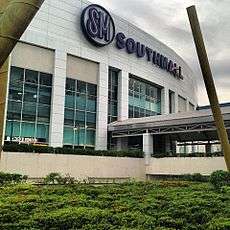
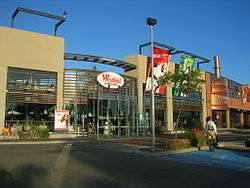
A super regional mall is, per the International Council of Shopping Centers, in the US a shopping mall with over 800,000 sq ft (74,000 m2) of gross leasable area, three or more anchors, mass merchant, more variety, fashion apparel, and serves as the dominant shopping venue for the region (25 miles) in which it is located.[31]
Fashion/specialty center
Fashion or specialty centers feature upscale apparel shops and boutiques and cater to customers with higher incomes. They usually have a retail area ranging from 80,000 to 250,000 square feet (7,400 to 23,200 m2) and serve an area of 5 to 15 miles (8.0 to 24.1 km).[30]
Power center
Power centers are large shopping centers that almost exclusively feature several big-box retailers as their anchors. They usually have a retail area of 250,000 to 600,000 square feet (23,000 to 56,000 m2) and a primary trade area of 5 to 10 miles (8.0 to 16.1 km).[30]
Theme/festival center

Theme or festival centers have distinct unifying themes that are followed by their individual shops as well as their architecture. They are usually located in urban areas and cater to tourists. They typically feature a retail area of 80,000 to 250,000 square feet (7,400 to 23,200 m2).[30]
Outlet center
An outlet mall (or outlet center) is a type of shopping mall in which manufacturers sell their products directly to the public through their own stores. Other stores in outlet malls are operated by retailers selling returned goods and discontinued products, often at heavily reduced prices. Outlet stores were found as early as 1936, but the first multi-store outlet mall, Vanity Fair, located in Reading, PA did not open until 1974. Belz Enterprises opened the first enclosed factory outlet mall in 1979, in Lakeland, TN, a suburb of Memphis.[32]
Components
Food court
A common feature of shopping malls is a food court: this typically consists of a number of fast food vendors of various types, surrounding a shared seating area.
Department stores
When the shopping mall format was developed by Victor Gruen in the mid-1950s, signing larger department stores was necessary for the financial stability of the projects, and to draw retail traffic that would result in visits to the smaller stores in the mall as well. These larger stores are termed anchor store or draw tenant. In physical configuration, anchor stores are normally located as far from each other as possible to maximize the amount of traffic from one anchor to another.
Stand-alone stores
Frequently, a shopping mall or shopping center will have satellite buildings located either on the same tract of land or on one abutting it, on which will be located stand-alone stores, which may or may not be legally connected to the central facility through contract or ownership. These stores may have their own parking lots, or their lots may interconnect with those of the mall or center. The existence of the stand-alone store may have been planned by the mall's developer, or may have come about through opportunistic actions by others, but visually the central facility – the mall or shopping center – and the satellite buildings will often be perceived as being a single "unit", even in circumstances where the outlying buildings are not officially or legally connected to the mall in any way.
Dead malls
_crop.jpg)
In the United States, in the mid-1990s, malls were still being constructed at a rate of 140 a year.[33] But in 2001, a PricewaterhouseCoopers study found that underperforming and vacant malls, known as “greyfield” and “dead mall” estates, were an emerging problem. In 2007, a year before the Great Recession, no new malls were built in America, for the first time in 50 years.[34] City Creek Center Mall in Salt Lake City, which opened in March 2012, was the first to be built since the recession.[13]
In recent years, the number of dead malls increased significantly in the early twenty first century because the economic health of malls across the United States has been in decline, with high vacancy rates in these malls. From 2006 to 2010, the percentage of malls that are considered to be "dying" by real estate experts (have a vacancy rate of at least 40%), unhealthy (20–40%), or in trouble (10–20%) all increased greatly, and these high vacancy rates only partially decreased from 2010 to 2014.[35] In 2014, nearly 3% of all malls in the United States were considered to be "dying" (40% or higher vacancy rates) and nearly one-fifth of all malls had vacancy rates considered "troubling" (10% or higher). Some real estate experts say the "fundamental problem" is a glut of malls in many parts of the country creating a market that is "extremely over-retailed".[35]
New trends
In parts of Canada, it is now rare for new shopping malls to be built. The Vaughan Mills Shopping Centre, opened in 2004, and Crossiron Mills, opened in 2009, are the only malls built in Canada since 1992. Outdoor outlet malls or big box shopping areas known as power centers are now favored, although the traditional enclosed shopping mall is still in demand by those seeking weather-protected, all-under-one-roof shopping. In addition, the enclosed interconnections between downtown multi story shopping malls continue to grow in the Underground city of Montreal (32 kilometres of passageway),[36] the PATH system of Toronto (27 km (17 mi) of passageway)[37] and the Plus15 system of Calgary (16 km (9.9 mi) of overhead passageway).[38]
In Russia, on the other hand, as of 2013 a large number of new malls had been built near major cities, notably the MEGA malls such as Mega Belaya Dacha mall near Moscow. In large part they were financed by international investors and were popular with shoppers from the emerging middle class.[39]
In the United States, owners are making drastic moves to convert struggling malls. This includes converting malls into apartments, offices and industrial space. Other owners have taken the approach to turning large chunks of malls into parks and playgrounds. In Austin, Texas, Highland Mall is in the midst of a conversion to a community college. Much of the 600,000 square foot mall will be the home of Austin Community College.[14]
Vertical malls

High land prices in populous cities have led to the concept of the "vertical mall," in which space allocated to retail is configured over a number of stories accessible by elevators and/or escalators (usually both) linking the different levels of the mall. The challenge of this type of mall is to overcome the natural tendency of shoppers to move horizontally and encourage shoppers to move upwards and downwards.[40] The concept of a vertical mall was originally conceived in the late 1960s by the Mafco Company, former shopping center development division of Marshall Field & Co. The Water Tower Place skyscraper, Chicago, Illinois, was built in 1975 by Urban Retail Properties. It contains a hotel, luxury condominiums, and office space and sits atop a block-long base containing an eight-level atrium-style retail mall that fronts on the Magnificent Mile.
Vertical malls are common in densely populated conurbations such as Hong Kong and Bangkok. Times Square in Hong Kong is a principal example.[40]
A vertical mall may also be built where the geography prevents building outward or there are other restrictions on construction, such as historical buildings or significant archeology. The Darwin Shopping Centre and associated malls in Shrewsbury, UK, are built on the side of a steep hill, around the former outer walls of the nearby medieval castle;[41] consequently the shopping center is split over seven floors vertically – two locations horizontally – connected by elevators, escalators and bridge walkways. Some establishments incorporate such designs into their layout, such as Shrewsbury's McDonalds restaurant, split into four stories with multiple mezzanines which feature medieval castle vaults – complete with arrowslits – in the basement dining rooms.
Online shopping influence
Faced with the exploding popularity of buying online, shopping malls are emptying and are seeking new solutions to generate traffic. In the US, for example, roughly 200 out of 1,300 malls across the country are going out of business.[42] To combat this trend, developers are trying to turn malls into leisure centers that include attractions such as parks, movie theaters, gyms, and even fishing lakes.[43] Others, such as the European commercial real-estate giant Unibail-Rodamco, are modernizing their approach by promoting brand interaction and enhanced architectural appeal. A recent example that integrates both approaches is the So Ouest mall outside of Paris that was designed to resemble elegant, Louis XV-style apartments and includes 17,000 square metres (180,000 sq ft) of green space.[44] The Australian mall company Westfield launched an online mall (and later a mobile app) with 150 stores, 3,000 brands and over 1 million products.[45] Online shopping has increased its share of total retail sales since 2008. In Q3 2008, it comprised 3.6% of retail purchases and this increased to 7.4% by Q3 2015.[14]
Shopping property management firms
A shopping property management firm is a company that specializes in owning and managing shopping malls. Most shopping property management firms own at least 20 malls. Some firms use a similar naming scheme for most of their malls; for example, Mills Corporation puts "Mills" in most of its mall names and SM Prime Holdings of the Philippines puts "SM" in all of its malls, as well as anchor stores such as SM Department Store, SM Appliance Center, SM Hypermarket, SM Cinema, and SM Supermarket. In the UK, The Mall Fund changes the name of any center it buys to "The Mall (location)", using its pink-M logo; when it sells a mall the center reverts to its own name and branding, such as the Ashley Centre in Epsom.[46]
Shopping center management and advisory firms are bringing about professional management practices to the largely fragmented shopping center development industry in India. Historically, land ownership in India, has been fragmented and as a byproduct shopping center development, which rendered the single mall developers vulnerable to dubious advice and practices, since standard benchmarks, knowledge resources, and skilled people were scarce. This is changing as new firms promoted by former shopping center managers are stepping in to bridge the gap between ownership and professional management.
Beyond Squarefeet[47] from India is another mall management company, which is foraying into various other countries such as India, Iran, Nepal, Nigeria, Qatar, etc. Mall management is slowly becoming a trend and is much sought after services in Asia and other markets.
Legal issues
One controversial aspect of malls has been their effective displacement of traditional main streets or high streets. Some consumers prefer malls, with their parking garages, controlled environments, and private security guards, over CBDs or downtowns, which frequently have limited parking, poor maintenance, outdoor weather, and limited police coverage.[48][49]
In response, a few jurisdictions, notably California, have expanded the right of freedom of speech to ensure that speakers will be able to reach consumers who prefer to shop, eat, and socialize within the boundaries of privately owned malls.[50] See Pruneyard Shopping Center v. Robins.
Gallery
World's largest shopping malls/centers
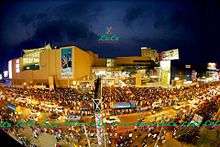
 The Port Grand Food and Entertainment Complex in Karachi is not only one of the most high-profile shopping mall in the city, but is also Asia's largest food street.
The Port Grand Food and Entertainment Complex in Karachi is not only one of the most high-profile shopping mall in the city, but is also Asia's largest food street..jpg)
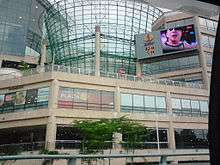


- Plaza Las Américas, the largest shopping mall in the Caribbean in San Juan, Puerto Rico

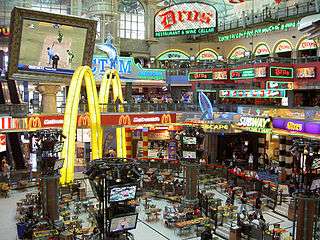
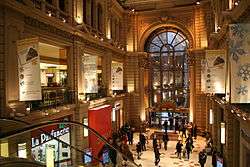


 West Edmonton Mall in Alberta, Canada
West Edmonton Mall in Alberta, Canada

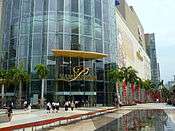
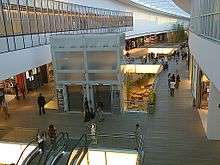 The Village Mall in Rio de Janeiro, Brazil
The Village Mall in Rio de Janeiro, Brazil- Gateway Theatre of Shopping in Durban, South Africa

See also
References
- ↑ Geist, Johann Friedrich. Arcades: The History of a Building Type. Cambridge, Mass: MIT Press (MA). ISBN 0262570629.
- ↑ MacKeith, Margaret (1986). The history and conservation of shopping arcades. London, New York: Mansell Pub. ISBN 0720117577.
- 1 2 Urban Geography: A Global Perspective Michael Pacione, (Routledge, Informa UK Ltd. 2001) ISBN 978-0-415-19195-1.
- ↑ "ICnetwork.co.uk". Icbirmingham.icnetwork.co.uk. 2003-09-04. Retrieved 2011-08-01.
- 1 2 Agovino, Theresa. "Investors Find Bargains at Europe's Outlet Malls". Wall Street Journal. ISSN 0099-9660. Retrieved 2015-12-03.
- ↑ "shopping in ancient Rome". Mariamilani.com. Retrieved 2012-11-09.
- ↑ "Ministry of tourism, Syria". Retrieved 2011-04-06.
- ↑ "Archaeology Data Service: myADS" (PDF). archaeologydataservice.ac.uk. Retrieved 2015-12-17.
- ↑ "Passage du Caire". Insecula.com. Retrieved 2012-11-09.
- ↑ "The Arcade, Providence RI". Brightridge.com. Retrieved 2009-07-17.
- ↑ Icons of Cleveland: The Arcade. Cleveland Magazine, August 2009.
- 1 2 "Essay – Dawn of the Dead Mall". The Design Observer Group. 11 November 2009. Retrieved 14 February 2010.
- 1 2 Moore, Robbie. "The Death of the American Mall and the Rebirth of Public Space". The International. Retrieved 26 February 2013.
- 1 2 3 Pleven, Liam (November 24, 2015). "Shrinking U.S. Shopping Malls Get Makeovers". Wall Street Journal. ISSN 0099-9660. Retrieved November 30, 2015.
- ↑ McBride, Bill (April 30, 2012). "Q1 2012 GDP Details: Office and Mall Investment falls to record low, Single Family investment increasese". Calculated Risk Blog.
- ↑ Pocock, Emil. "Shopping Center Studies at Eastern Connecticut State University". Eastern Connecticut State University. Retrieved 4 September 2011.
- ↑ "Big changes ahead for Sacramento's Town & Country Village, tenants say". Sacramento Bee. Retrieved 19 January 2013.
- ↑ "A History of Shoppers' World". Matt Bowling. Retrieved February 23, 2013.
- ↑ "Appleton's Valley Fair Center". Mall Hall of Fame. November 1, 2006. Retrieved 2015-10-21.
- ↑ Bathroom Reader's Institute. "The Mall: A History". Uncle John's Heavy Duty Bathroom Reader. Bathroom Reader's Press. pp. 99–101. ISBN 978-1-60710-183-3.
- ↑ Gladwell, Malcolm (March 15, 2004). "The Terrazzo Jungle". The New Yorker.
- ↑ "Celebrate 150 - City of London Ontario Canada". Celebrate150.london.ca. Archived from the original on 2010-04-30. Retrieved 2011-08-01.
- ↑ Bathroom Reader's Institute. "A History of the Shopping Mall, Part III". Uncle John's Heavy Duty Bathroom Reader. Bathroom Reader's Press. p. 401. ISBN 978-1-60710-183-3.
- ↑ Johnson, Caitlin A. (April 15, 2007). "For Billionaire There's Life After Jail". CBS News. Archived from the original on 2010-12-04. Retrieved 2009-12-29.
Alfred Taubman is a legend in retailing. For 40 years, he's been one of America's most successful developers of shopping centers. Taubman picked upscale areas and opened lavish shopping centers. He was among the first to offer fountains and feature prestigious anchor stores like Neiman Marcus. The Mall at Short Hills in New Jersey is one of the most profitable shopping centers in the country. Taubman is famous for his attention to detail. He's very proud of the terrazzo tiles at Short Hills. "The only point that the customer actually touches the shopping center is the floor," he said. "They've got traction as they're walking. Very important. Some of our competitors put in carpet. Carpet's the worst thing you can have because it creates friction."
- ↑ Peterson, Thane (April 30, 2007). "From Slammer Back To Glamour". Business Week. Retrieved 2009-12-29.
Shopping mall magnate and onetime Sotheby's (BID) owner Alfred Taubman, 83, may be a convicted felon, but he's continuing to insist on his innocence in his just-out autobiography, Threshold Resistance: The Extraordinary Career of a Luxury Retailing Pioneer (Collins, $24.95). Writing on his business triumphs, Taubman is heavy on the boilerplate. But he gives a juicy personal account of the Sotheby's-Christie's price-fixing scandal that sent him to the slammer.
- ↑ "Shoppers Throng to Opening of Bergen Mall in Jersey". The New York Times. November 15, 1957. Retrieved 2007-06-07.
Paramus, New Jersey, November 14, 1957. The $40,000,000 Bergen Mall regional shopping center opened here this morning.
- ↑ "10 Shopping Centers Scheduled For Allied Stores Within 3 Years". The New York Times. January 13, 1955. p. 37. (subscription required (help)).
- ↑ "The Super Centers". TIME. January 24, 1955. Retrieved 2008-06-25.
The new centers, scheduled for opening by 1957, are designed to serve regions (i.e. customers within 40 minutes' driving time) rather than smaller suburban areas. The first to go into operation will be the $30 million Bergen Mall at Paramus, N.J., expected to be the biggest US shopping center. Puckett estimates that there are 1,588,000 customers within the 40-minute radius.
- ↑ "World's Largest Shopping Malls". Eastern Connecticut State University. January 2007. Archived from the original on 2008-03-29. Retrieved 2008-07-29.
- 1 2 3 4 5 6 "ICSC Shopping Center Definitions: Basic Configurations and Types" (PDF). International Council of Shopping Centers. 1999. Retrieved 31 January 2013.
- 1 2 "US Shopping-Center Classification and Characteristics" (PDF). International Council of Shopping Centers. August 2015. Retrieved November 13, 2015.
- ↑ University of San Diego webpage. Retrieved June 1, 2007.
- ↑ Millar, Lisa (January 20, 2015). "Dead malls: Half of America's shopping centres predicted to close by 2030". Australian Broadcasting Corporation News. Retrieved 2015-10-21.
- ↑ "The death of the US shopping mall". BBC News. November 4, 2014.
- 1 2 Schwartz, Nelson D. (January 3, 2015). "The Economics (and Nostalgia) of Dead Malls". The New York Times. Retrieved 2015-10-21.
- ↑ "Underground City, Montreal". A View on Cities. Retrieved 2015-10-21.
- ↑ "PATH - Toronto's Downtown Underground Pedestrian Walkway". City of Toronto. Retrieved 2015-10-21.
- ↑ "Calgarys Plus15 Skywalk". City of Calgary. Archived from the original on December 25, 2014. Retrieved 2015-10-21.
- ↑ Kramer, Andrew E. (January 1, 2013). "Malls Blossom in Russia, With a Middle Class". The New York Times. Retrieved January 2, 2013.
I feel like I’m in Disneyland
- 1 2 Chung, Danny (December 9, 2005). "Reach for the sky". The Standard.
- ↑ "Discovering Shropshire's History: Shrewsbury Town Walls". Discovershropshire.org.uk. 1987-10-26. Retrieved 2011-08-01.
- ↑ "Online Sales Threat to American Malls". Financial Times. 4 February 2013.
- ↑ Evans, Peter (20 February 2013). "Malls' New Spin on Leisure". The Wall Street Journal.
- ↑ "So Ouest lance l'offensive anti-e-shopping". Challenges. 18 October 2012.
- ↑ "Westfield launches new 'online mall' with 100,000 products". The Australian Financial Review. November 19, 2013. Retrieved 2015-10-21.
- ↑ This is Surrey (May 22, 2009). "Moka, Ashley Centre, Epsom". Surrey Mirror. Retrieved 2015-10-21.
- ↑ "Our Services". Beyond Squarefeet. Retrieved 2015-10-21.
- ↑ O'Donahue, Tony (May 1, 2005). The Tale of a City: Re-Engineering the Urban Environment. Toronto: Dundurn Press Ltd. p. 43. ISBN 978-1550025569. (subscription required (help)).
- ↑ Frieden, Bernard J.; Sagalyn, Lynne B. (1989). Downtown, Inc.: How America Rebuilds Cities. Cambridge, MA: MIT Press. p. 233. ISBN 978-0262560597. Retrieved 2015-10-21.
- ↑ Judd, Dennis R. (1991). "The Rise of the New Walled Cities". Maxine Goodman Levin College of Urban Affairs, Cleveland State University.
Further reading
- Hardwick, M. Jeffrey. Mall Maker: Victor Gruen, Architect of an American Dream (2004) excerpt and text search
- Howard, Vicki. From Main Street to Mall: The Rise and Fall of the American Department Store (2015)
- Ngo-Viet, Nam-Son. Google Docs 2002. The Integration of the Suburban Shopping Center with its Surroundings: Redmond Town Center (PhD Dissertation) University of Washington.
- Scharoun, Lisa. America at the Mall: The Cultural Role of a Retail Utopia (Jefferson, NC: McFarland, 2012) 263 pp.
External links
| Wikimedia Commons has media related to Shopping malls. |
- International Council of Shopping Centers (ICSC)
- American Institute of Architects Retail and Entertainment Committee Knowledge Community
